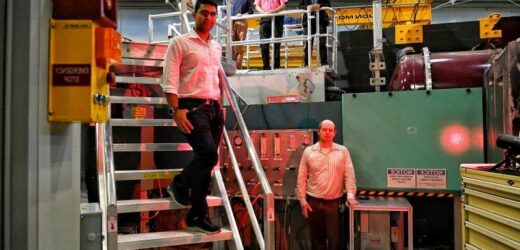The two may seem to have little to do with each other, but deep in the bowels of the Lucas Heights nuclear facilities a team of scientists is building the firefighting uniform of the future, specifically for Australian conditions.
They have fashioned an ultra-light fireproof material that could revolutionise firefighting gear and protect household items with a simple coating, and after nearly six years of research are ready to commercialise their invention.
The inorganic compound is made from a metal carbide using an atomic process refined at the Lucas Heights nuclear reactor in a collaboration between the Australian Nuclear Science and Technology Organisation (ANSTO) and the University of NSW.
Nuclear scientists from ANSTO and UNSW have created a lightweight fire-resistant compound that could revolutionise firefighting uniforms.Credit:Nick Moir
Lead researcher Guan Heng Yeoh, a hydraulic specialist at ANSTO, said the material could replace traditional firefighting suits that are weighed down by heavy carbon compounds, contributing to fatigue and dehydration.
Because it is so thin and light it could potentially be used as a protective coating on any surface, including firefighting equipment or household items such as couches or chairs.
“The thickness of the material, you’re talking about two to three nanometres,” Professor Yeoh said. “The weight gain is only 5 per cent, but we are getting a maximum fire reduction of 50 to 70 per cent.”
Scientists at ANSTO’s Centre for Neutron Scattering used a special instrument, the Bilby small-angle neutron scatterer, to bombard the neutrons in a two-dimensional metal carbide compound called an MXene. This allowed them to study and describe in detail the atomic and molecular structure of the material, which is originally a mixture of aluminium, titanium and carbon.
“When we remove the aluminium, what remains are actually layers of titanium carbide in its raw form,” Professor Yeoh said. These nano-sheets are then layered with bio-based or “green” flame retardants extracted from natural material such as shrimp or oyster shells.
“We can mix it together and apply it to furniture. We tested it with polyurethane foams which are commonly used in beds,” said Anthony Chun Yin Yuen, a researcher in polymeric nanocomposites, fire and combustion at UNSW.
“It not only reduces the flame significantly because the foam is highly flammable itself but [when] burning it reduces the smoke and toxicity release, which has always been a problem.”
In 2020, the NSW government imported 15,000 new Kevlar-embedded firefighting uniforms from the United Kingdom for the state’s Fire and Rescue crews, Nine News reported.
The teams from ANSTO and UNSW believe their discoveries could be the genesis for a uniquely Australian style of fire uniform tailored for the extreme heat of the Australian summer.
“There’s been no need for innovation in fire-retardant compounds in cold weather climates like Europe, but in Australia, simply wearing existing fire suits in our 40-degree summers can be a hazard,” they said.
The teams are now investigating how to scale up and commercialise their invention. Dr Yuen said the lengthy chemical process to etch out the aluminium from the MXene required a very acidic solution and had a low yield, so research was required about how to mass-produce the material.
“We also need to look at the performance and characteristics of the material at higher temperatures up to 800 degrees,” Professor Yeoh said.
The Morning Edition newsletter is our guide to the day’s most important and interesting stories, analysis and insights. Sign up here.
Most Viewed in National
From our partners
Source: Read Full Article



